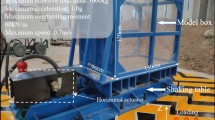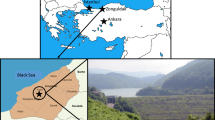Abstract
Evaluating liquefaction potential is essential for seismic micro-zonation for a specific area. Ground improvement of a site is conducted after the examination of the propensity of liquefaction of that site. The present study aims to evaluate the liquefaction potential and risk assessment for the world’s largest mobile manufacturing Plant in Noida city, which comes under Gautam Buddha Nagar district (U.P.), India, for different magnitudes of earthquakes, i.e., 7.5, 7.0, and peak ground acceleration (\(a_{\max }\) = 0.24 g). For this purpose, the factor of safety against liquefaction was evaluated at different depths from 32 boreholes and soil samples based on stress based approach derived from Idriss and Boulanger (Soil Dyn Earthq Eng 26:115–130, 2006) and the liquefaction potential risk index of the particular site was evaluated further. The results show that the study area is mainly comprised of silt and sand and falls under site class D (as per IBC International Code Council (2006) International building code (IBC). Washington, DC). The middle part of the study area shows high liquefaction potential. From the following analysis, 3D liquefaction potential risk models are prepared for classifying the boreholes from “very low” to “very high” (Iwasaki et al. in Proceedings of the 3rd international conference on microzonation, Seattle, vol 3, no 2, pp 1310–1330, 1982) along their depth. This rapid approach can be helpful for the future construction of earthquake-resilient structures and it may also help determine the risk of current underground structures like buried pipelines and metro railways, which are critical lifeline infrastructures of a city.








Similar content being viewed by others
Data availability
Some or all data, models, or codes that support the findings of this study are available from the corresponding author upon reasonable request.
References
Ashikuzzaman M, Hossain A, Salan MSA (2023) Liquefaction assessment of Rajshahi city corporation, Bangladesh. Indian Geotech J 53:455–464. https://doi.org/10.1007/s40098-022-00671-7
Ayothiraman R, Raghu Kanth STG, Sreelatha S (2012) Evaluation of liquefaction potential of Guwahati: gateway city to Northeastern India. Nat Hazards 63:449–460
BIS-1893 (2016) Indian standard criteria for earthquake resistant design of structures, part 1—general provisions and buildings
Bray JD, Sancio RB (2006) Assessment of the liquefaction susceptibility of finegrained soils. J Geotech Geoenviron Eng 132(9):1165–1177. https://doi.org/10.1061/(ASCE)1090-0241(2006)132:9(1165)
CGWB (2013) Report on aquifer mapping and ground water management plan, Parts of NCR, Uttar Pradesh, Central Ground Water Board, Ministry of Water Resources, River Development and Ganga Rejuvenation Government of India
Chu B, Hsu S, Chang Y (2004) Ground behavior and liquefaction analyses in central Taiwan Wufeng. Eng Geol 71(1–2):119–139. https://doi.org/10.1016/S0013-7952(03)00129-7
Das S, Ghosh S, Kayal JR (2019) Liquefaction potential of Agartala City in Northeast India using a GIS platform. Bull Eng Geol Environ 78:2919–2931
Dasgupta S, Pande P, Ganguly D, Iqbal Z, Sanyal K, Venkatraman NV, Dasgupta S, Sural B, Harendranath L, Mazumdar K, Sanyal S, Roy A, Das LK, Misra PS, Gupta H (2000) Seismotectonic Atlas of India and its Environ, Geological Survey of India
Day RW (2002) Geotechnical earthquake engineering handbook. McGraw-Hill, New York
Dixit J, Dewaikar DM, Jangid RS (2012) Assessment of liquefaction potential index for Mumbai city. Nat Hazard 12(9):2759–2768
GSI (2020) Miscellaneous Publication No.-30: Part XIII. Geology and Mineral resources of the States of India, Part XIII: Uttar Pradesh
GSI (2003) KUTCH (BHUJ) EARTHQUAKE 26 JANUARY 2001 Geological Survey of India, Special Publication No. 76
Humar JM, Lau D, Pierre JR (2001) Performance of buildings during the 2001 Bhuj earthquake. Can J Civ Eng 28(6):979–991
Idriss IM, Boulanger RW (2006) Semi-empirical procedures for evaluating liquefaction potential during earthquakes. Soil Dyn Earthq Eng 26:115–130
International Code Council (2006) International building code (IBC). Washington, DC
IS 2131 (1981) IS 2131: 1981 Indian standard, method for standard penetration test for soils. Indian Stand
IS 2720 (Part 3) (1980) Methods of test for soils-determination of specific gravity. Bur Indian Stand
IS 2720 (Part 4) (1985) Methods of test for soils: grain size analysis. Bur Indian Stand
IS 2720-29 (1975) Method of test for soils, determination of dry density of soil In-place by the core cutter method. Bur Indian Stand
IS: 2720 (part 5) (1985) Methods of test for soils: determination of liquid limit and plastic limit. Indian Stand 1–16
IS:2720-Part 2 (1973) Indian standard methods of test for soils: determination of water content. Bur Indian Stand New Delhi, India
IS: 1893:2016 (Part-I) Criteria for earthquake resistant design of structures, Bureau of Indian Standards, New Delhi, 2016. [Online]. https://archive.org/details/1893Part12016
Iwasaki T, Tokida KI, Tatsuoka F, Watanabe S, Yasuda S, Sato H (1982) Microzonation for soil liquefaction potential using simplified methods. In: Proceedings of the 3rd international conference on microzonation, Seattle, vol 3, no 2, pp 1310–1330
Jalil A, Fathani TF, Satyarno I, Wilopo W (2021) Liquefaction in Palu: the cause of massive mudflows. Geoenviron Disast 8(1):1–14. https://doi.org/10.1186/S40677-021-00194-Y
Joshi DD, John B, Kandpal GC, Pande P (2009) Paleoliquefaction features from the Himalayan Frontal Belt, India and its implications to the status of ‘Central Seismic Gap.’ JS Asia Disast Stud 2(1):139–154
Mayne PW, Christopher BR, DeJong J (2001) Manual on subsurface investigations. Nat. Highway Inst. Sp. Pub. FHWA NHI-01–031. Fed. Highway Administ, Washington, DC
Mhaske SY, Choudhury D (2010) GIS-based soil liquefaction susceptibility map of Mumbai city for earthquake events. J Appl Geophys 70(3):216–225
Nath SK, Srivastava N, Ghatak C, Adhikari MD, Ghosh A, Sinha Ray SP (2018) Earthquake induced liquefaction hazard, probability and risk assessment in the city of Kolkata, India: its historical perspective and deterministic scenario. J Seismol 22:35–68
Novikova T, Papadopoulos GA, Karastathis V (2007) Evaluation of ground motion characteristics, effects of local geology and liquefaction susceptibility: the case of Itea, Corinth Gulf (Greece). Nat Hazards 40(3):537–552. https://doi.org/10.1007/s11069-006-9018-9
Phule RR, Choudhury D (2015) Seismic liquefaction hazard zonation and contour maps for Mumbai city using open source GIS. Disast Adv 8(7):20–33
Pokhrel RM, Gilder CE, Vardanega PJ, De Luca F, De Risi R, Werner MJ, Sextos A (2022) Liquefaction potential for the Kathmandu Valley, Nepal: a sensitivity study. Bull Earthq Eng 20(1):25–51
Prakash R, Shrivastava J (2012) A review of the seismicity and seismotectonics of Delhi. J Geol Soc India 79:603–617
Rahman MZ, Siddiqua S (2017) Evaluation of liquefaction-resistance of soils using standard penetration test, cone penetration test, and shear-wave velocity data for Dhaka, Chittagong, and Sylhet cities in Bangladesh. Environ Earth Sci 76(5):207
Rahman MZ, Siddiqua S, Kamal AM (2015) Liquefaction hazard mapping by liquefaction potential index for Dhaka City, Bangladesh. Eng Geol 188:137–147
Rao KS, Satyam DN (2007) Liquefaction studies for seismic microzonation of Delhi region. Curr Sci 92(5):646–654
Samsung Inaugurates World’s Largest Mobile Factory in India; Honourable Prime Minister Shri Narendra Modi Flags-off ‘Make for the World’ (2018) Samsung Newsroom India, https://news.samsung.com/in/samsung-inaugurates-worlds-largest-mobile-factory-in-india
Sana H, Nath SK (2016) Liquefaction potential analysis of the Kashmir valley alluvium, NW Himalaya. Soil Dyn Earthq Eng 85:11–18
Seed HB, Idriss IM (1971) Simplified procedure for evaluating soil liquefaction potential. J Soil Mech Found Div ASCE 97(SM9):1249–1273
Seed RB, Stokoe KH (2001) Liquefaction resistance of soils, summary report from the 1996 NCEER and 1998, NCEER/NSF workshop on evaluation of liquefaction resistance of soils. J Geotech Geoenviron Eng ASCE 127(10):817–833
Seed HB, Idriss IM, Arnago I (1983) Evaluation of liquefaction potential using field performance data. J Geotech Eng ASCE 109(3):458–483
Seed BH, Tokimatsu K, Harder L, Chung RM (1985) Influence of SPT procedures in soil liquefaction resistance evaluations. J Geotech Eng 111(12):1425–1445
Sharma B, Hazarika PJ (2013) Assessment of liquefaction potential of Guwahati city: a case study. Geotech Geol Eng 31:1437–1452
Sharma ML, Wason HR, Dimri R (2003) Seismic zonation of the Delhi Region for bedrock ground motion. Pure Appl Geophys 160(12):2381–2398. https://doi.org/10.1007/s00024-003-2400-6
Singh SK (2002) Ground motion in Delhi from future large/great earthquakes in the central seismic gap of the Himalayan Arc. Bull Seismol Soc Am 92(2):555–569. https://doi.org/10.1785/0120010139
The Times of India (2018) World’s Largest Mobile Manufacturing Factory to Be Inaugurated in India, July 9, 2018. https://timesofindia.indiatimes.com/business/india-business/worlds-largest-mobile-manufacturing-factory-to-be-inaugurated-in-india/articleshow/64914431.cms. Accessed 10 July 2021
Thoithoi L, Dubey CS, Ningthoujam PS, Shukla DP, Singh RP, Naorem SS (2016) Liquefaction potential evaluation for subsurface soil layers of Delhi region. J Geol Soc India 88:147–150
Tosun H, Seyrek E, Orhan A, Savaş H, Türköz MURAT (2011) Soil liquefaction potential in Eskişehir, NW Turkey. Nat Hazard 11(4):1071–1082
Tsuchida H, Hayashi S (1972) Estimation of liquefaction potential of sandy soils. Mcgraw Hill Book Company, New York, p 14
Verma M, Singh RJ, Bansal BK (2014) Soft sediments and damage pattern: a few case studies from large Indian earthquakes vis-a-vis seismic risk evaluation. Nat Hazards 74(3):1829–1851. https://doi.org/10.1007/s11069-014-1283-4
Wadi D, Wu W, Malik I, Ahmed HA, Makki A (2021) Assessment of liquefaction potential of soil based on standard penetration test for the upper Benue region in Nigeria. Environ Earth Sci 80:1–11
Youd TL, Perkins DM (1978) Mapping liquefaction-induced ground failure potential. J Geotech Eng Div 104(4):433–446
Youd TL, Idriss IM, Andrus RD, Arango I, Castro G, Christian JT, ... Moriwati Y, Power MS, Roberson PK, Seed RB, Stokoe KH (2001) Liquefaction resistance of soils: summary report from the 1996 NCEER and 1998 NCEER/NSF workshops on evaluation of liquefaction resistance of soils. J Geotech Geoenv Engg 127(10):817–833
Acknowledgements
We thank Sai Geotechnical Engineers Pvt. Ltd., Explore Engineering Consultants Pvt. Ltd. for providing the borehole geotechnical data. The first author is thankful Dr. A. P. Singh (Director, Explore Engineering Consultants Pvt. Ltd) and Narender Singh Bisht (Chief Geotechnical Engineer, Sai Geotechnical Engineers Pvt. Ltd.) for his insightful comments on the lithology of Noida. We would also like to thank the anonymous reviewers for their critical review and constructive suggestions that significantly improved the quality of the manuscript.
Author information
Authors and Affiliations
Contributions
Author 1 wrote the main manuscript text and compile all the technical details. Author 2 did the review, helps in preparation of tables and figures. Author 3 does overall correction of the manuscript and helps in preparation of result and discussion section.
Corresponding author
Ethics declarations
Competing interests
The authors declare no competing interests.
Additional information
Publisher's Note
Springer Nature remains neutral with regard to jurisdictional claims in published maps and institutional affiliations.
Rights and permissions
Springer Nature or its licensor (e.g. a society or other partner) holds exclusive rights to this article under a publishing agreement with the author(s) or other rightsholder(s); author self-archiving of the accepted manuscript version of this article is solely governed by the terms of such publishing agreement and applicable law.
About this article
Cite this article
Kundu, P., Pain, A. & Das, J. Earthquake-induced liquefaction potential and risk assessment of the world’s largest mobile manufacturing plant, Noida, Uttar Pradesh. Environ Earth Sci 83, 194 (2024). https://doi.org/10.1007/s12665-024-11494-5
Received:
Accepted:
Published:
DOI: https://doi.org/10.1007/s12665-024-11494-5




